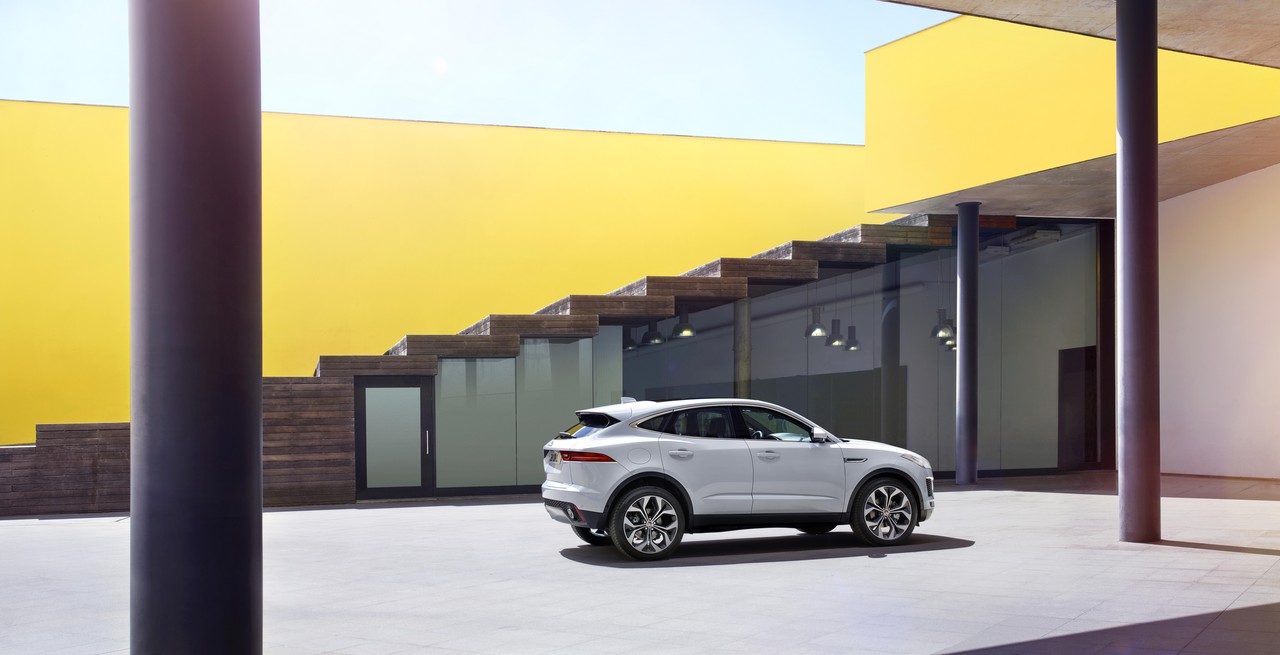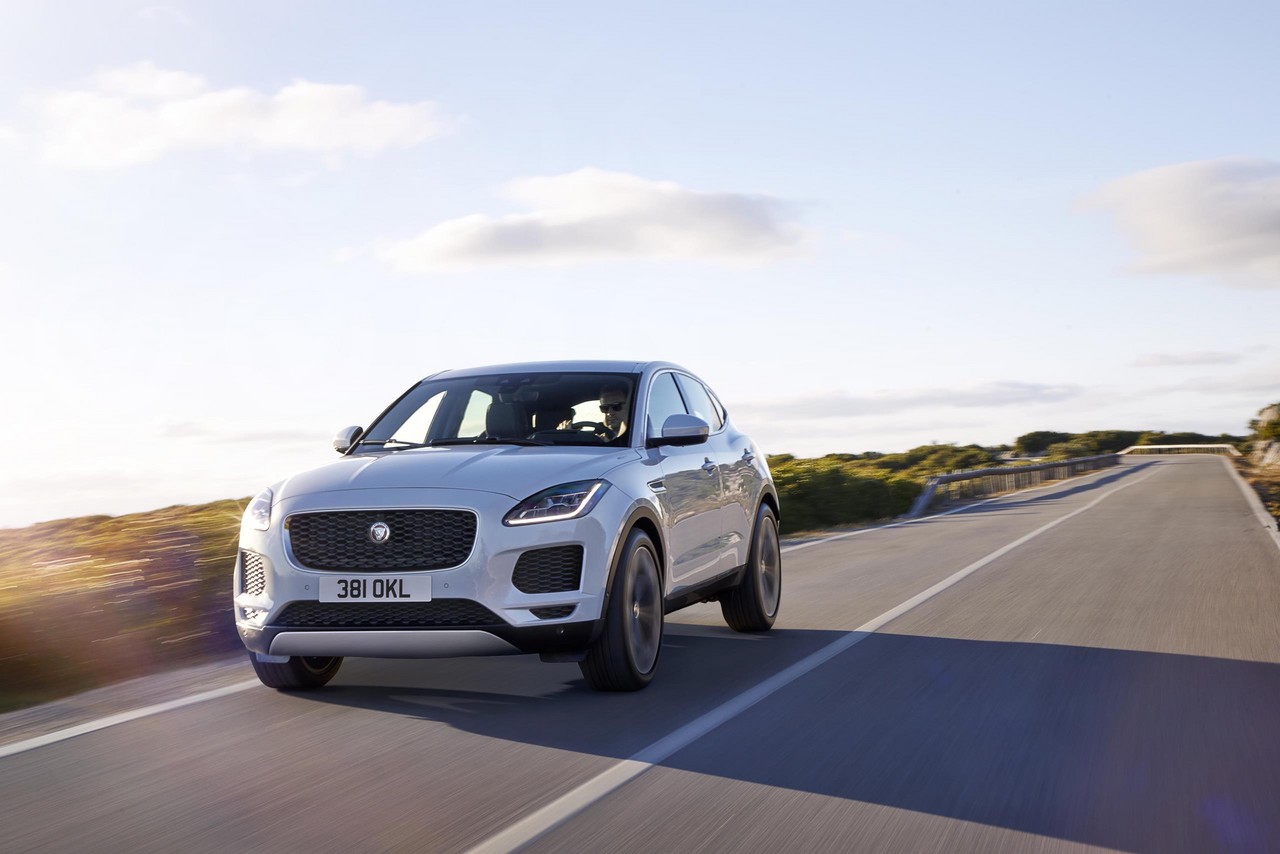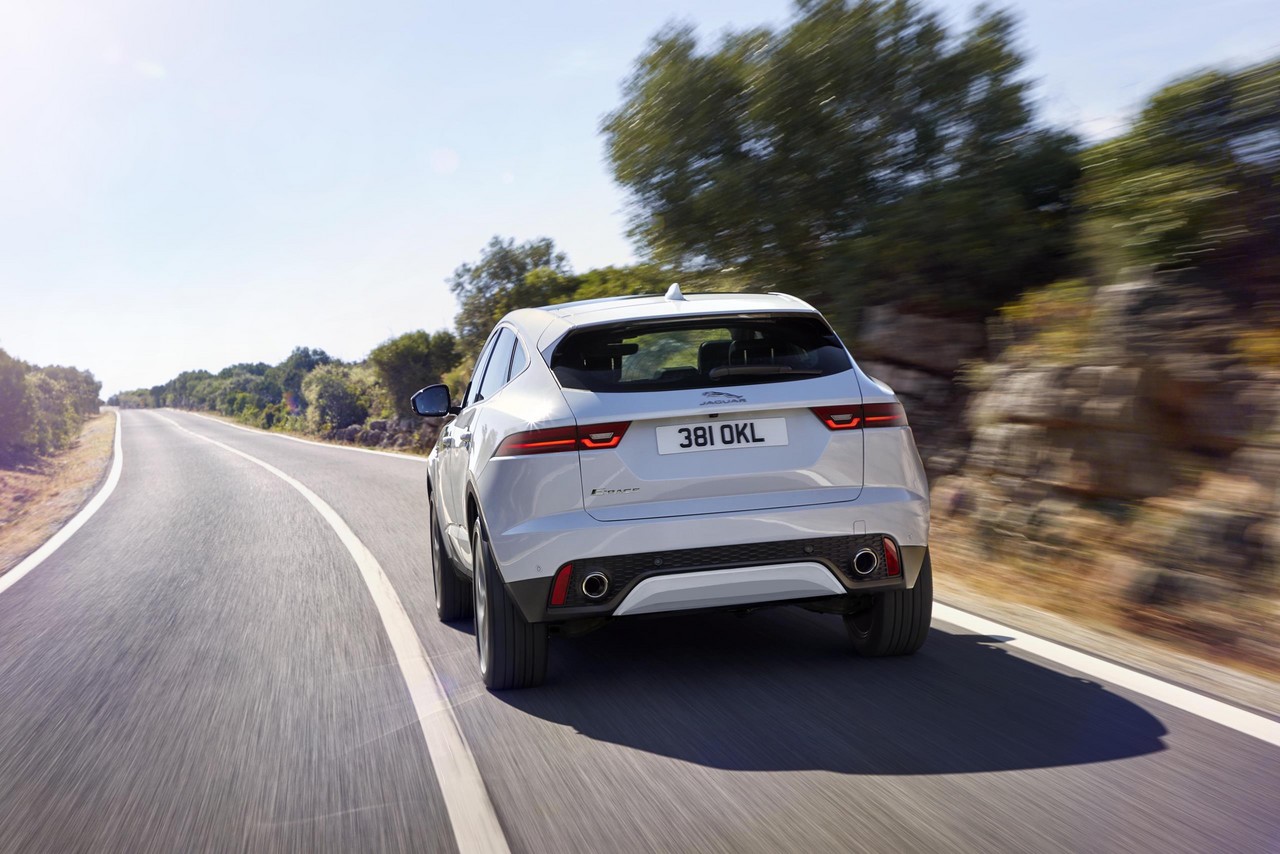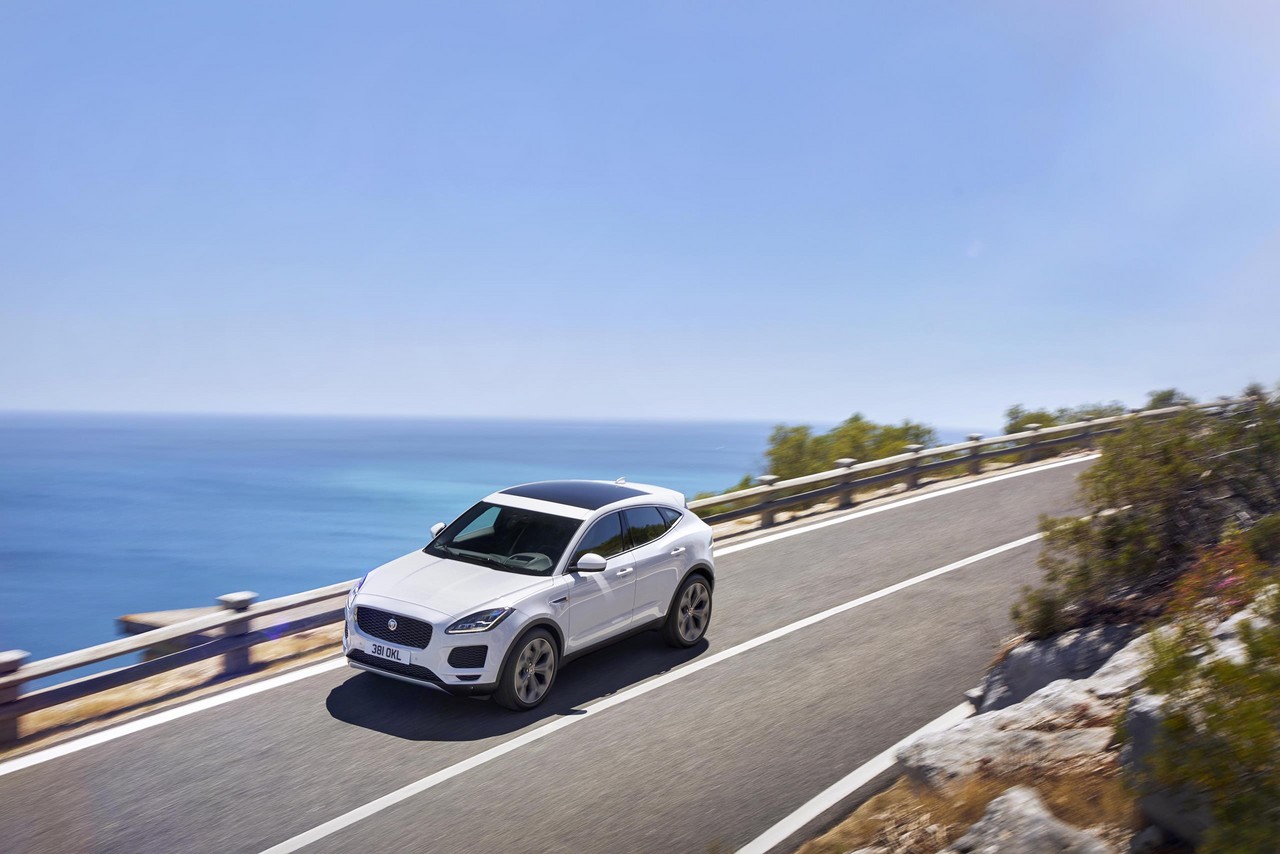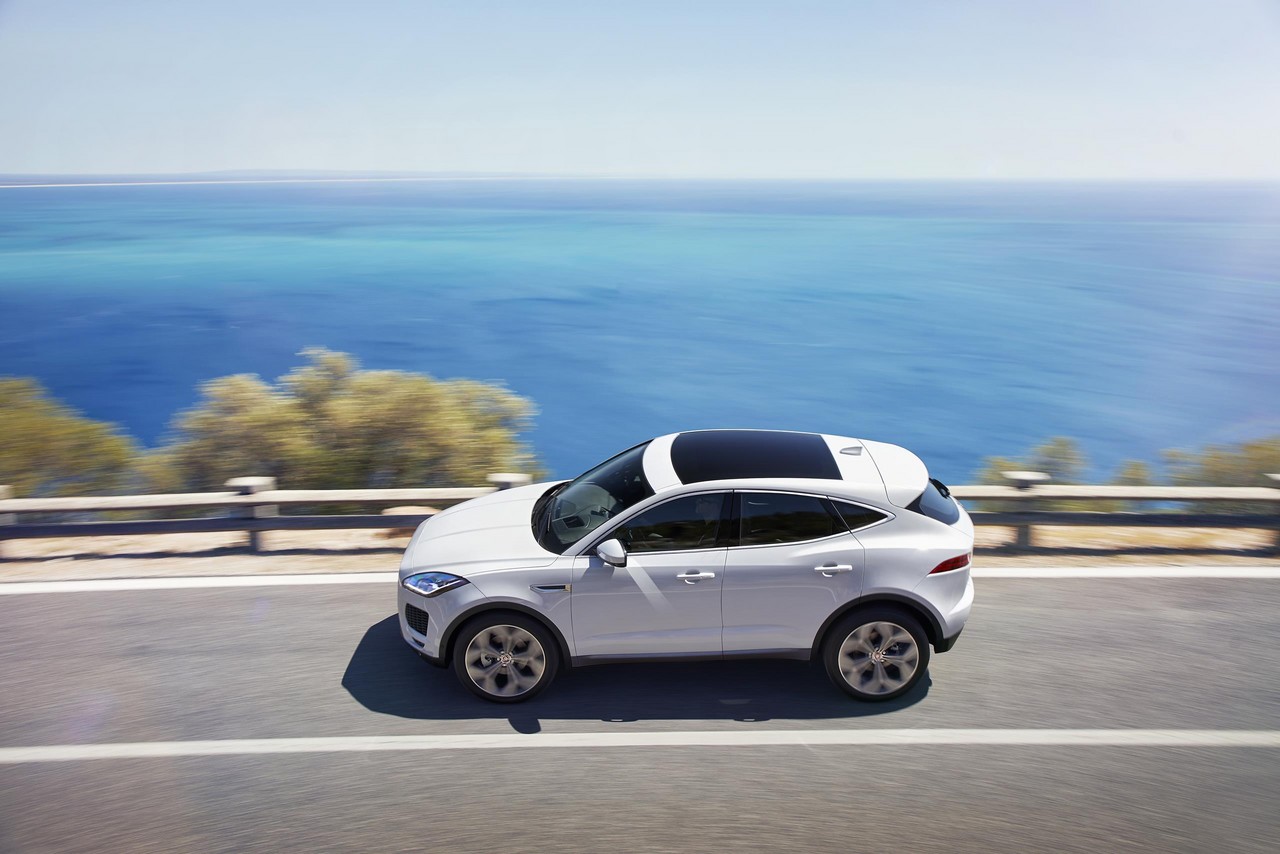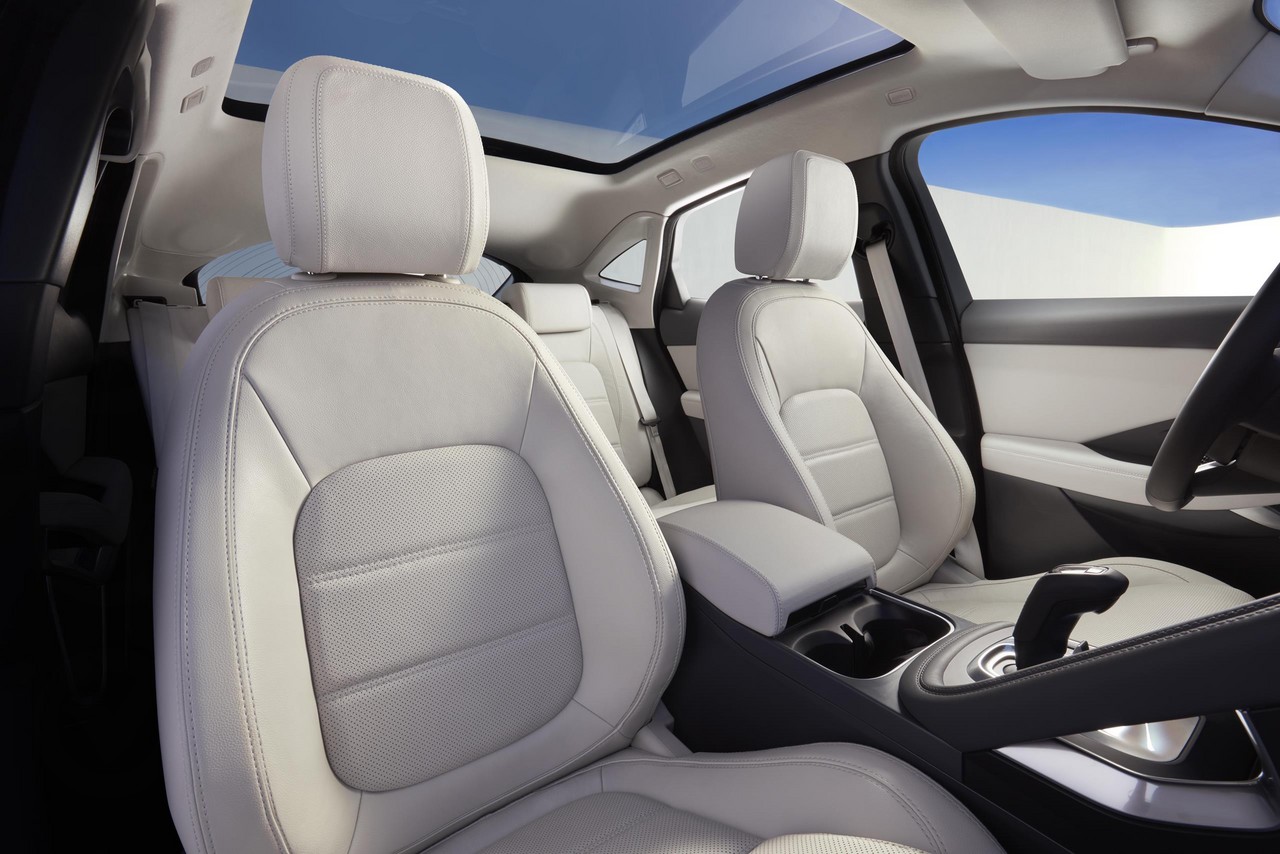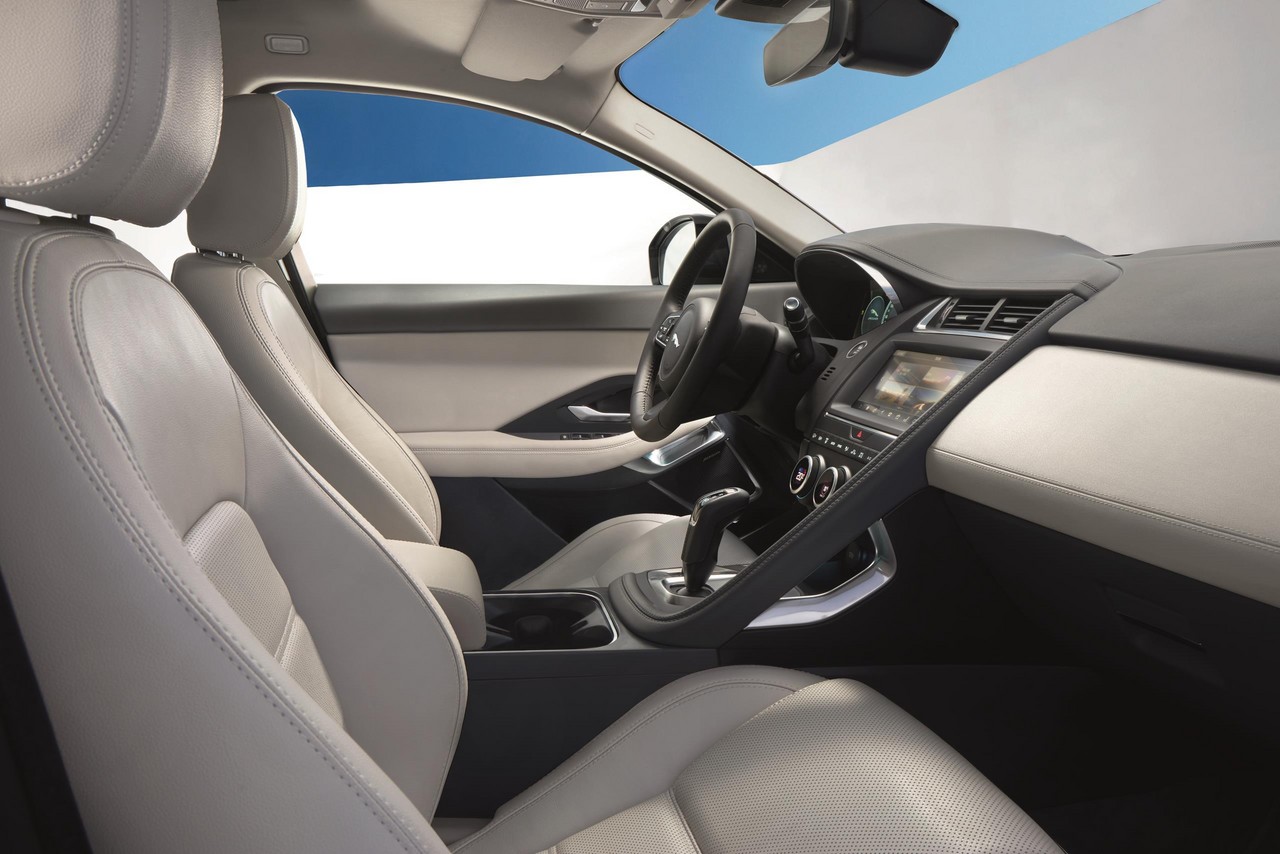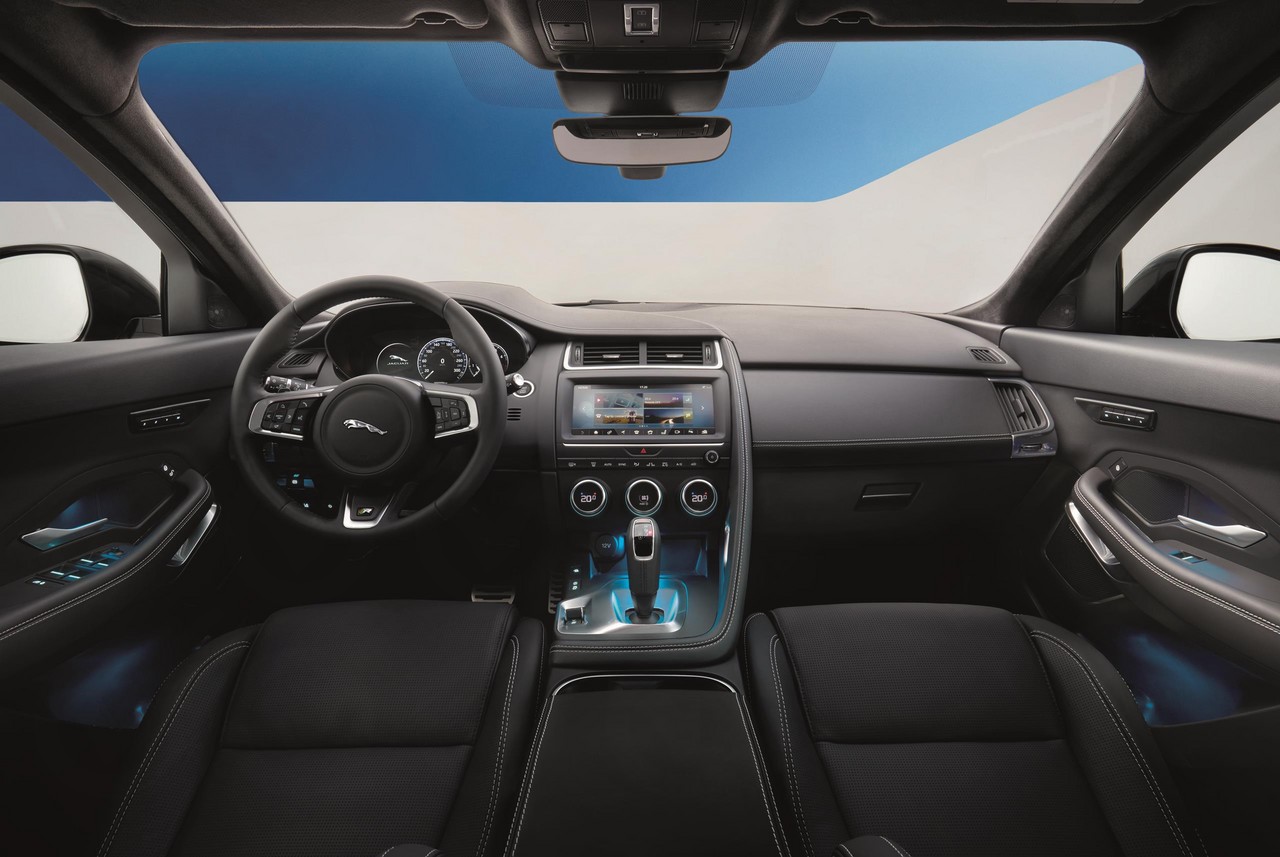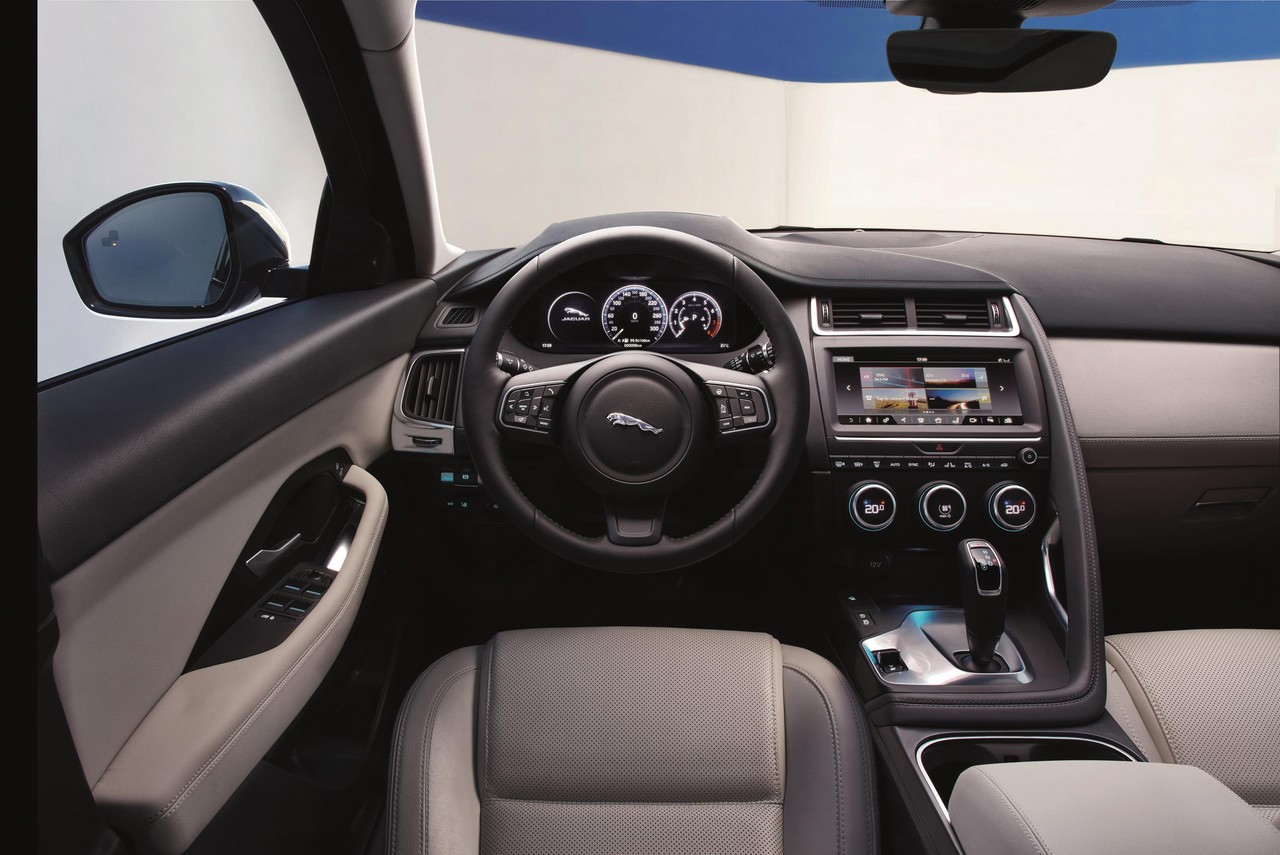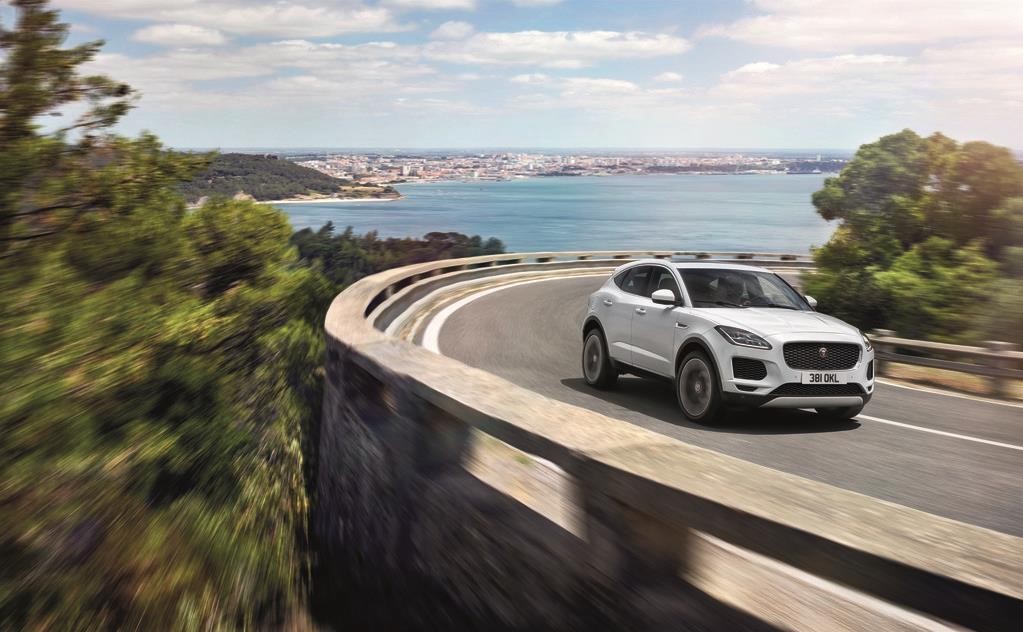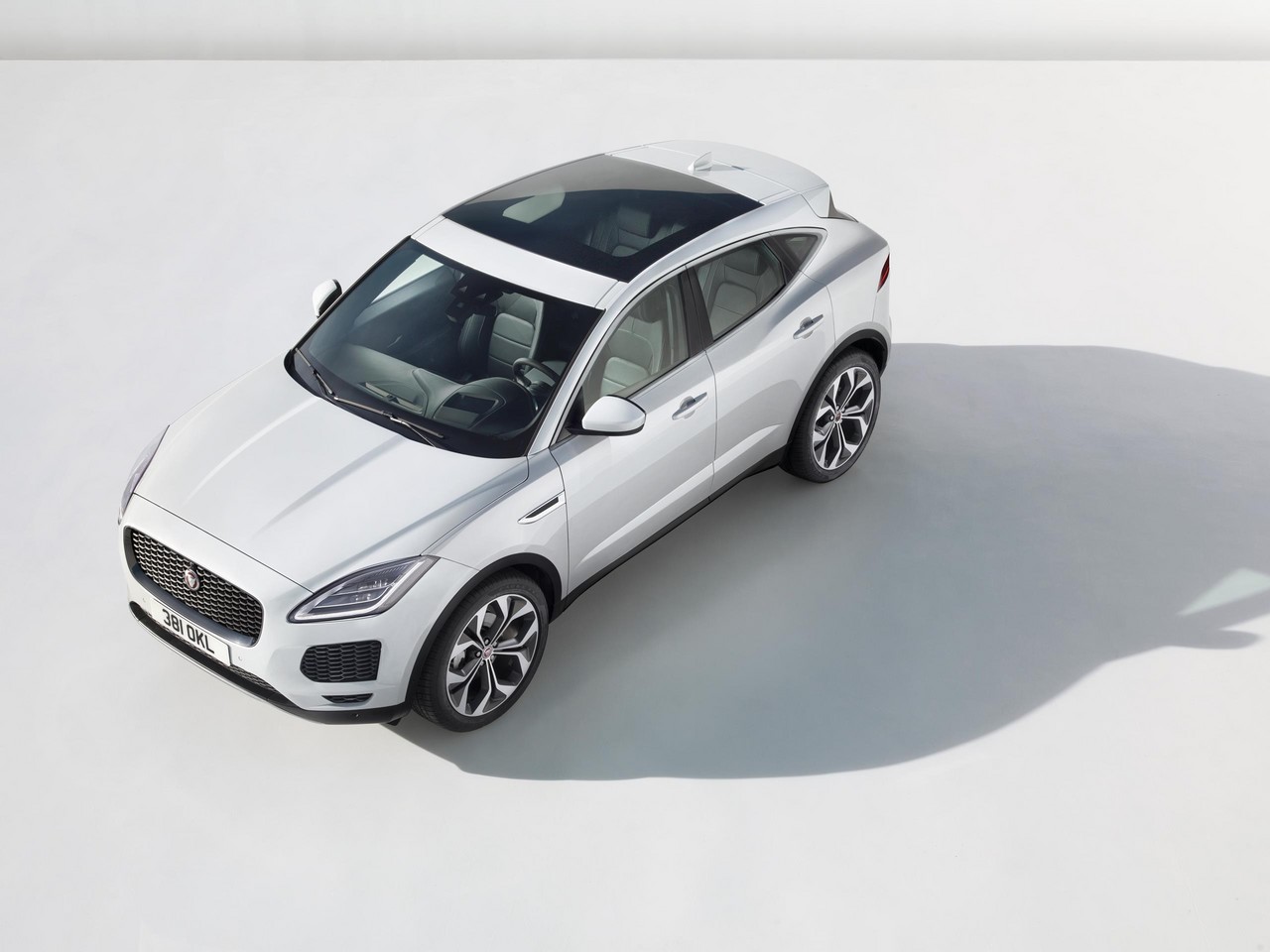
- Availability of all-wheel drive traction
- Steering is accurate and well-weighted
- Nine-speed ZF transmissions provide refined gearshifts…
- … but is reluctant to kick down for acceleration
- Idle noise and vibration from 2.0-litre ‘Ingenium’ diesel engines
- Suspension compliance falls short of Jaguar’s standards, particularly at low speeds
- Body roll when cornering
- Sloping roofline reduces luggage space
- Steering wheel buttons feel cheap
- The E-Pace is heavier than the aluminium-intensive F-Pace
Overview
Released in Australia in March 2018, the Jaguar E-Pace was a compact SUV. Manufactured by Magna Steyr in Graz, Austria, the all-wheel drive Jaguar E-Pace was powered by Jaguar’s ‘Ingenium’ turbocharged petrol and diesel engines, and offered in D150, D180, D240, P250 and P300 variants (see table below). Beyond the engine-based variants, the Jaguar E-Pace was available in standard, S, SE and HSE editions, while an R-Dynamic pack can also be specified.
The Jaguar E-Pace was the first transverse-engined Jaguar since the X400 X-Type .
Ingenium engines
The 2.0-litre turbocharged petrol and diesel engines were members of Jaguar Land Rover’s ‘Ingenium’ engine family and, as such, had deep-skirt aluminium cylinder blocks with thin-wall, press-fit cast iron liners. Beyond this,
- The 2.0-litre diesel engine had offset cylinder bearings, common-rail injection operating at up to 1800 bar, a single variable geometry turbocharger, double overhead camshafts with roller bearings, four valves per cylinder, a cam phaser for variable exhaust valve timing, a compression ratio of 15.5:1, exhaust gas recirculation (EGR), AdBlue selective catalytic reduction (SCR) systems, split-cooling systems and twin counter-rotating balancer shafts. The D240 engine, however, had two sequential turbochargers and a compression ratio of 15.34:1; and,
- The 2.0-litre ‘Ingenium’ turbocharged petrol engine had an exhaust manifold which was integrated with the cylinder head casting, direct petrol injection operating at 200 bar, a twin-scroll turbocharger, double overhead camshafts, four valves per cylinder, variable intake and exhaust valve timing, continuously variable intake valve lift (CVVL), a compression ratio of 10.5:1 and twin counter-rotating balancer shafts.
| Variant | Edition | Engine | Drive | Trans. | Peak power | Peak torque |
|---|---|---|---|---|---|---|
| D150 | Standard, S, SE, HSE |
1999 cc turbo diesel I4 | AWD | 9sp auto. | 110 kW at 3500 rpm | 380 Nm at 1750 rpm |
| D180 | Standard, S, SE, HSE |
1999 cc turbo diesel I4 | AWD | 6sp man., 9sp auto |
132 kW at 4000 rpm | 430 Nm at 1750 rpm |
| D240 | S, SE, HSE |
1999 cc biturbo diesel I4 | AWD (Active Drive line) |
9sp auto | 177 kW at 4000 rpm | 500 Nm at 1500 rpm |
| P250 | Standard, S, SE, HSE |
1998 cc turbo petrol I4 | AWD | 9sp auto | 183 kW at 5500 rpm | 365 Nm at 1200-4500 rpm |
| P300 | S, SE, HSE |
1998 cc turbo petrol I4 | AWD (Active Drive line) |
9sp auto | 221 kW at 5500 rpm | 400 Nm at 1500-4500 rpm |
All-wheel drive systems: Standard Driveline and Active Driveline
The Jaguar E-Pace was available with two all-wheel drive systems: the Standard Driveline and the Active Driveline. The Standard Driveline was a torque on demand system which distributed torque between the front and rear axles to maximise stability and handling, or where appropriate, fuel economy.
Available on the E-Pace D240 and P300 (and fitted as standard for Australian-delivered vehicles), AustralianCar.Reviews understands that the Active Driveline system has a rear bias in normal conditions to provide a ‘rear-wheel-drive character’. With the Active Driveline, sensors monitor yaw, throttle position, steering angle and lateral acceleration so that software can analyse driving conditions and calculate the optimum torque distribution every 10 milliseconds (0.01 seconds). During steady state cruising, however, Active Driveline disengaged the AWD system such that the vehicle was front wheel drive only – this reduce parasitic losses and improved fuel economy. However, the system could re-engage AWD seamlessly within just 300 milliseconds (0.3 seconds) when a change in driving conditions was detected.
At the rear axle, the Active Driveline had two independent electronically-controlled wet-plate clutches that distributed torque between the rear wheels, with the capability to direct 100 per cent of that torque to either rear wheel in 100 milliseconds (0.1 seconds). If understeer was detected, additional torque was directed to the outer wheel generate yaw; if oversteer is detected, both rear clutches were locked to provide yaw damping. On low-friction surfaces, the Active Driveline could allow the driver to initiate power-on oversteer and maintain a controlled drift.
All Surface Progress Control and Torque Vectoring by Braking
For models with automatic transmissions, the Jaguar E-Pace was fitted with Jaguar’s ‘All-Surface Progress Control’ (ASPC) which controlled acceleration at speeds up to 30 km/h. Operating at speeds between 1.8 km/h and 30 km/h, the driver could activate ASPC and use the cruise control switches on the steering wheel to set the maximum speed. ASPC then accelerated the vehicle up to that speed, controlling the throttle and brakes (in opposition) to optimise traction on low-friction surfaces such as snow and ice.
For the Jaguar E-Pace, the electronic stability control system had a ‘torque vectoring by braking’ function which could brake individual wheels to generate yaw when understeer or oversteer was detected.
Body and dimensions
The Jaguar E-Pace was underpinned by the Jaguar Land Rover D8 architecture which was shared with the Land Rover L550 Discovery Sport . As such, the body of the Jaguar E-Pace had a torsional stiffness of 28.7 kN/degree and featured ultra-high strength steels (including hot-formed boron steel to re-inforce the A- and B-pillars), aluminium and advanced composites. For mass reduction, the Jaguar E-Pace had:
- An aluminium bonnet and fenders (reducing mass by 10 kg and 3 kg, respectively, relative to steel);
- An aluminium roof (for a mass reduction of 6 kg);
- An aluminium tailgate (for a mass reduction of 15 kg) which used a riveting/bonding process developed by Jaguar and laser welding on selected joints;
- A magnesium cast cross-car beam to support the instrument panel; and,
- High formability steel for the bodysides which were 0.7 mm thick.
Compared to the Jaguar X761 F-Pace , the Jaguar E-Pace was 336 mm shorter (at 4395 mm), 3 mm lower (1649 mm) and had a 193 mm shorter wheelbase (2681 mm). Furthermore, the E-Pace had a luggage capacity of 577 litres, though this increased to 1234 litres when the 60:40 split folding rear seats were lowered and luggage was filled to the roofline.
The Jaguar E-Pace had a drag co-efficient of 0.325 Cd for the D150 and D180 variants; this increased, however, to 0.34 Cd for the D240 and P250, and to 0.36 Cd for the P300.
Suspension
The Jaguar E-Pace had MacPherson strut front suspension with a lower control arm and integral multi-link rear suspension. Both the front and rear suspension had coil springs, passive dampers and passive anti-roll bars.
As an extra-cost option, the Jaguar E-Pace was available with ‘Adaptive Dynamics’ suspension which consisted of continuously variable dampers that had a triple-tube design and an externally mounted hydraulic valve to control damping. According to Jaguar, this design provided faster responses and better inside/outside wheel force distribution when compared to previous systems. Adaptive Dynamics monitored vehicle movements every 2 milliseconds and calculated the required damping force every 10 milliseconds. Based on steering angle, throttle position, body and wheel movements, Adaptive Dynamics could also pre-emptively adjust suspension damping for improved roll control and agility.
Jaguar’s ‘Configurable Dynamics’ system enabled the driver to select from the following drive modes: ‘Normal’, ‘Dynamic’, ‘ECO’ and ‘Rain, Ice and Snow’. These settings adjusted throttle response mapping, steering assistance, gearshift speed and, where fitted, the Adaptive Dynamics suspension.
Steering
The Jaguar E-Pace had rack-and-pinion steering with electric power assistance; the steering wheel required 2.31 turns from lock to lock, while the E-Pace had a turning circle of 11.46 metres (kerb-to-kerb).
Safety equipment
Standard safety equipment for the Jaguar E-Pace included dual front airbags, front seat-mounted side airbags, full-length curtain airbags, ABS, electronic brake force distribution, brake assist, electronic stability control, traction control and front seatbelts with pre-tensioners and load limiters. The Jaguar E-Pace also had an ‘Active Bonnet’ and a pedestrian airbag; in the event of a pedestrian collision, the Active Bonnet would rise to create additional clearance between the bonnet and hard structures in the engine bay. If the impact occurred at driving speeds between 25 and 50 km/h, the pedestrian airbag would deploy (within 50-60 milliseconds of the collision) from underneath the trailing edge of the bonnet to cover the base of the windscreen.
As standard, the Jaguar E-Pace was equipped with –
- Emergency Braking: used a forward-facing stereo camera – mounted behind the front windscreen – to generate a 3D view of the road up to 100 metres ahead. At speeds up to 80 km/h, this information was used to detect if a collision is imminent and, if so,
- The braking system would be pre-charged;
- The driver would receive a visual warning in the instrument cluster (and head-up display where fitted); and,
- If the driver failed to respond, autonomous emergency braking would be initiated to avoid or mitigate a collision;
- Lane Keep Assist (LKA): could return the vehicle to the centre of its lane by applying a small amount of counter-steering through the steering system. However, this steering torque could be over-ridden by the driver; and,
- Driver Condition Monitoring: monitored driver behaviour for signs of fatigue and provided multi-stage warnings in the instrument panel recommending the driver take a break.
The Jaguar E-Pace S, SE and HSE were also equipped with a ‘Rear Traffic Monitor’ which could detect vehicles, pedestrians or other hazards approaching from either side of the vehicle when the driver was reversing out of a parking bay. If detected, the driver would be alerted via audio and visual warnings.
As standard, the Jaguar E-Pace SE and HSE editions were both fitted with a ‘Drive Pack’ which included –
- Adaptive Cruise Control (ACC) with Queue Assist: ACC used a long-range 77 GHz radar to maintain a safe distance from the vehicle ahead with automated braking. Furthermore, Queue Assist enables the E-Pace to accelerate from rest by tracking the vehicle ahead;
- High-speed Emergency Braking: extended the speed threshold for Emergency Braking from 80 km/h to 160 km/h; and,
- Blind Spot Assist: if another vehicle was detected in the E-Pace’s blind spot and the driver attempted to steer into its lane, Blind Spot Assist would apply corrective steering torque to prevent the lane change. Furthermore, the driver would be simultaneously alerted by a flashing LED in the corresponding door mirror.
Euro NCAP testing
In Euro NCAP testing , the Jaguar E-Pace received a five star safety rating which included an 86 per cent adult occupant protection rating, an 87 per cent child occupant rating and a 72 per cent ‘safety assist’ rating. In the frontal offset test, insufficient pressure in the driver’s airbag caused the driver’s head to make slight contact with the steering wheel such that a penalty was applied. Furthermore, protection of the driver’s chest was rated as marginal and lower left leg protection was rated as weak. Maximum points were awarded in the side impact test; in the more severe pole test, however, protection of the driver’s chest was rated as adequate.
Features: Jaguar E-Pace
As standard, the Jaguar E-Pace was equipped with Jaguar’s ‘Touch Pro’ infotainment system which has a ten-inch touchscreen in a 21:9 super-wide ratio (1280 x 542 pixels), Bluetooth mobile phone connectivity and audio streaming, and voice control.
Beyond this, standard features for the Jaguar E-Pace included 17-inch ten-spoke alloy wheels, a 125 watt Jaguar Sound System, dual-zone climate control air conditioning, fabric seat upholstery, eight-way manually adjustable front seats, cruise control with speed limiter, LED head- and tail-lights, dusk-sensing headlights, rain-sensing wipers, a rear-view camera, front and rear parking sensors, a leather-wrapped steering wheel, 60:40 split fold rear seats, remote central locking, power mirrors, power windows, a height and reach adjustable steering wheel, push-button start, four 12 volt power sockets, two USB inputs, a five-inch display within the instrument panel, illuminated vanity mirrors, a cargo cover, trip computer, an alarm and immobiliser.
FFeatures: Jaguar E-Pace S
Relative to the standard Jaguar E-Pace, the E-Pace S added 18-inch alloy wheels, Jaguar’s ‘Navigation Pro’ system, grained leather upholstery, ten-way power adjustable front seats, ‘signature’ daytime running lights (DRLs) for the headlights, an auto-dimming interior rear view mirror. Furthermore, the door mirrors had power folding, heating, auto-dimming and approach lighting functions.
The Jaguar E-Pace S, SE and HSE were also fitted with –
- A ‘Park Pack’ which included –
- 360 degree parking Aid: used sensors around the vehicle to provide a virtual overhead view of the vehicle on the central touchscreen. As the driver manoeuvred the vehicle, the touchscreen would display would update and the driver would receive audio feedback to indicate the distances to obstacles;
- Rear Traffic Monitor (see ‘Safety equipment’, above); and,
- Park Assist: provided automated steering for parallel and perpendicular parking manoeuvres; and,
- A ‘Connect Pro Pack’ which included:
- A 4G Wi-Fi hotspot that could provide in-car access to the Internet, enabling up to eight wireless devices to be used simultaneously; and,
- ‘Pro Services’ which included real time traffic updates, online search, route planning, share ETA, satellite view, parking service, online routing, safety camera and fuel price information.
Features: Jaguar E-Pace SE
Compared to the Jaguar E-Pace S, the E-Pace SE was further equipped with 19-inch alloy wheels, a 380 watt Meridian Sound System, fourteen-way power adjustable front seats, memory settings for the front seats and door mirrors, and a power-operated tailgate.
The Jaguar E-Pace SE was also equipped with ‘Auto High Beam Assist’ (AHBA) which could detect the lights of vehicles ahead and automatically dip the main beam for oncoming traffic.
Features: Jaguar E-Pace HSE
The range-topping Jaguar E-Pace HSE was distinguished by its 20-inch alloy wheels, perforated Windsor leather upholstery, eighteen-way power adjustable front seats and proximity key (i.e. keyless entry). As standard, the E-Pace HSE was also equipped with:
- A 12.3-inch configurable TFT display rather than conventional analogue instruments for the speedometer and tachometer; and,
- A ‘gesture tailgate’ which could open or close in response to foot movement beneath the rear bumper.
R-Dynamic pack
Separately from the S, SE and HSE editions, the Jaguar E-Pace could be specified with an R-Dynamic pack. The R-Dynamic package included a unique front bumper with fog lights and deeper outboard air intakes, gloss black finishes (for the front fog lights, grille, rear valance and tailpipe finishers), body-coloured wheel arch surrounds and side sills, and satin chrome highlights for the side vents and grille surrounds.
Inside, the R-dynamic package included sports seats with unique shoulder profiles and deeper bolsters, Ebony ‘Sportmesh’ seat fabrics with contrast stitching, soft-grained leather trim for the steering wheel, steering wheel gearshift paddles, Jet Morzine headlining and brushed stainless steel finishes for the ‘R-Dynamic’ treadplates and pedals.
Jaguar E-Pace First Edition
Available for its first year of sales, the Jaguar E-Pace First Edition was available in D180 and P250 variants. The E-Pace First Edition could be identified by its 20-inch Satin Grey diamond-turned six split-spoke alloy wheels and gloss black exterior detailing.
Although based on the E-Pace HSE, the E-Pace First Edition was fitted – as standard – with soft grain Ebony Windsor leather upholstery with Flame Red twin-needle contrast stitching, Ebony suedecloth headlining, a head-up display, ‘First Edition’ carpet mats and ‘First Edition’ metal treadplates. The E-Pace First Edition was also equipped with:
- A Thin-Film Transistor (TFT) head-up display. According to Jaguar, the TFT display could project up to 66 per cent more information onto the windscreen using large, full-colour graphics, including vehicle speed, navigation directions, alerts and updates for the infotainment, safety and convenience features; and,
- Jaguar’s ‘Activity Key’: a waterproof, shockproof wristband with an integrated transponder that enabled the driver to lock the keyfob securely inside the vehicle. The driver could then lock or unlock the E-Pace by holding the Activity Key in close proximity to the ‘J’ of the Jaguar lettering on the tailgate.
Specifications and brochure

